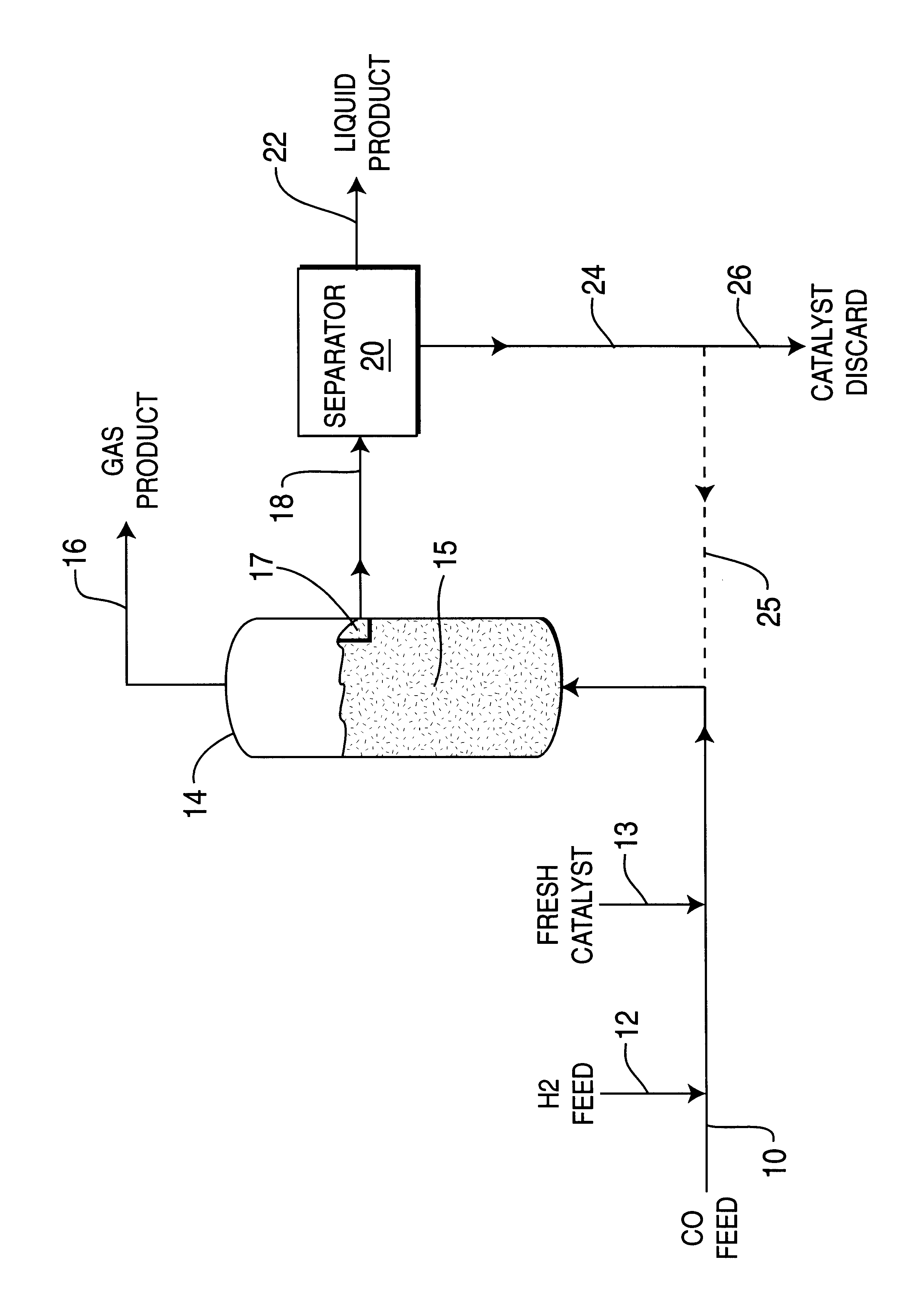Skeletal iron catalyst having improved attrition resistance and product selectivity in slurry-phase synthesis processes
a technology of skeletal iron and slurry-phase synthesis, which is applied in the direction of physical/chemical process catalysts, metal/metal-oxide/metal-hydroxide catalysts, hydrocarbon preparation catalysts, etc., can solve the problems of affecting the commercial use of the process, affecting the product quality and catalyst loss, and difficult to achieve reaction product waxes, etc., to achieve good particle strength and attrition resistance, easy to absorb, and large yield
- Summary
- Abstract
- Description
- Claims
- Application Information
AI Technical Summary
Benefits of technology
Problems solved by technology
Method used
Image
Examples
example 1
Mix powders iron, aluminum and a small amount of copper promotor metal powder in a respective weight proportion of 33:66:1 in an electric induction furnace, heat and melt the metal powders to form an iron metal alloy, then cool it to room temperature and pulverize the resulting iron alloy to 0.1-1.0 mm size precursor particles. Then provide a desired amount of 25% NaOH caustic solution in a stirred container, add the iron alloy precursor particles under hydrogen flow into the caustic solution maintained at 85.degree. C. temperature, and allow reaction to proceed for 30 minutes to extract and / or leach substantially the aluminum from the iron alloy particles. Wash the particles with deionized water to pH=7, displace water with water-free ethanol and store the resulting skeletal iron catalyst particles in ethanol.
Before being evaluated in a reaction system, the ethanol-containing skeleton iron catalyst is dried and reduced under high space velocity hydrogen at 300.degree. C. for 2 hour...
example 2
Mix powders iron and aluminum together with a small amount of copper promoter metal powder in weigh proportion 33:66:1 into an electric induction furnace, heat and melt the powders to form iron metal alloy, then cool it to room temperature and pulverize the iron alloy to 0.1-1.0 mm size precursor particles as for Example 1. Then provide a desire amount of 25% concentration NaOH in a stirred container under hydrogen stream, add the Fe-Al alloy particles into the NaOH caustic solution maintained at 75.degree. C. temperature, allow reaction for 30 minutes, to extract and / or leach substantially aluminum from the iron alloy particles. Then wash the particles with de-ionized water to pH=7, displace water with water-free ethanol and store skeletal iron catalyst particles in ethanol.
Next dry and reduce the ethanol-containing skeleton iron catalyst at 300.degree. C. under high space velocity hydrogen for 2 hours, and then transfer the catalyst into liquid reaction medium (liquid paraffin) in...
example 3
Mix iron and aluminum powders together with a small amount of copper promoter powder in weight ratio of 33:66:1, in an electric induction furnace, heat and melt the metal powders to form an iron-aluminum alloy, then cool to room temperature and pulverize to 0.1-1.0 mm precursor particle size same as for Example 1. Then add desired amount of 25% concentration NaOH caustic solution to a stirred container, add the Fe-Al alloy particles to the caustic solution maintained at 65.degree. C. temperature, and / or allow reaction for 30 minutes to extract and leach substantially the aluminum from the iron particles. Then wash the particles with de-ionized water to pH=7, displace water with water-free ethanol and store the resulting skeletal iron catalyst in ethanol.
Before the skeleton iron catalyst is evaluated in a reactor system, the ethanol-containing catalyst is dried and reduced at 300.degree. C. under high space velocity H.sub.2 for 2 hours, and is then transferred into slurry phase react...
PUM
| Property | Measurement | Unit |
|---|---|---|
| particle size | aaaaa | aaaaa |
| temperature | aaaaa | aaaaa |
| temperature | aaaaa | aaaaa |
Abstract
Description
Claims
Application Information
 Login to View More
Login to View More - R&D
- Intellectual Property
- Life Sciences
- Materials
- Tech Scout
- Unparalleled Data Quality
- Higher Quality Content
- 60% Fewer Hallucinations
Browse by: Latest US Patents, China's latest patents, Technical Efficacy Thesaurus, Application Domain, Technology Topic, Popular Technical Reports.
© 2025 PatSnap. All rights reserved.Legal|Privacy policy|Modern Slavery Act Transparency Statement|Sitemap|About US| Contact US: help@patsnap.com

